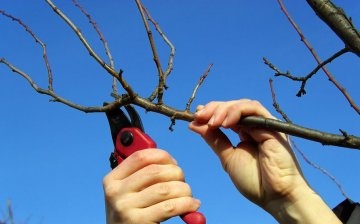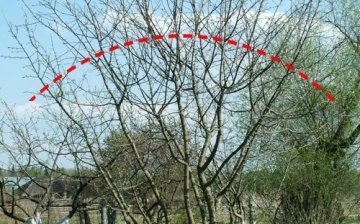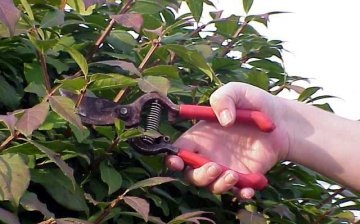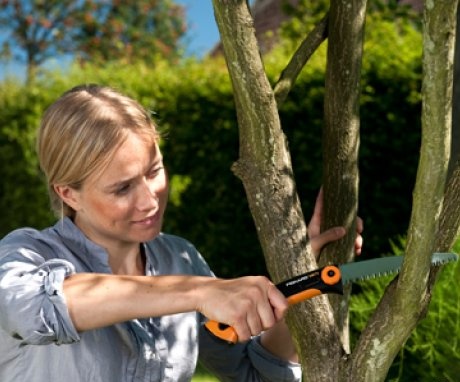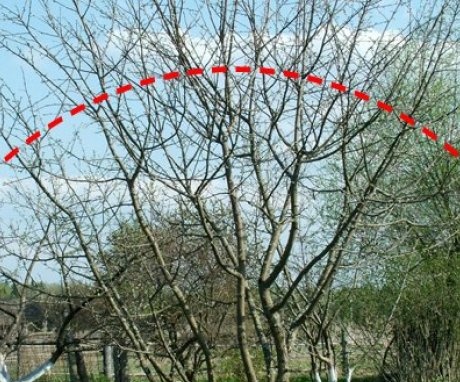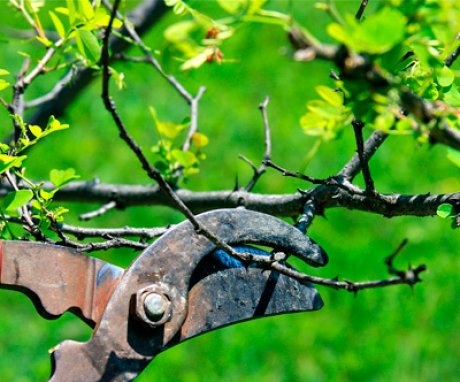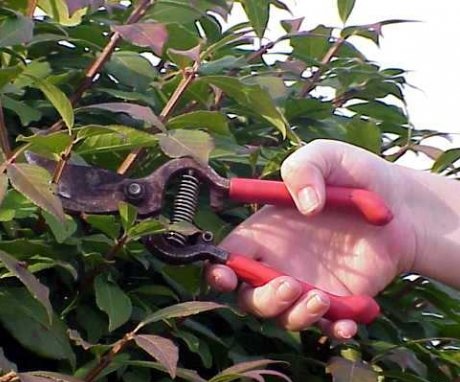When is the best time to prune a tree, what factors affect pruning time
In order for a fruit tree or shrub to give a bountiful harvest, it must not only be watered and fed, but also cut off. Why are some plants pruned in the fall and some in the spring?
Content:
- Basic rules for pruning fruit trees
- How to properly trim the crown
- Prune your tree in spring or fall?
- Shrub pruning
Basic rules for pruning fruit trees
When growing fruit trees, much attention is paid to their pruning. This is one of the basic conditions for the successful development of a tree and a good harvest.
By pruning fruit trees in spring, you can achieve the correct crown, which will be in the shape of a bowl.
The open center allows enough air and light to pass through, which is necessary for the tree to grow normally.
Each tree has its own characteristics. Some are more difficult to cut, some are easier. There is another question between gardeners: when to prune a tree - in spring or autumn. But there is no single answer to this question either. The hardest thing prune the pear... It does not grow everywhere, only in warm regions. Gardeners are afraid to cut off the excess, which is why the tree overgrows with excess shoots and gives a more meager harvest.
Stone fruit trees are cut according to a single scheme:
- Among them: cherry, almonds, apricot, peach, sweet cherry, cherry plum, plum... This is done after the leaves appear, that is, in any period from early spring to late autumn. Thus, there is no risk of getting a fungal disease.
- Cherries are pruned in the first year after planting. It is especially important to do this if the one-year-old seedling branches poorly or does not branch at all.
- A young cherry sapling, which is from one to 3 years old, is pruned to activate the lateral buds. Young growth is cut off at 25-30% of the length. You may encounter the following problem: lateral branches can depart at an acute angle from the trunk, which interferes with the formation of the correct crown shape.
- Since cherry branches are fragile, they can break off under their own weight. These corners also need to be removed. If the angle is more than 20 °, then the shoot is transferred to the lateral branch.
As for the pear, together with other fruit and stone fruits trees pruned in spring, if the climate in the region is cold, and if the climate is warm, then in winter. You can cut off branches only during the dormant period, while there are no leaves and even more so flowers. You need to have time to do the pruning before the buds appear. First, the crown is thinned out, and why the shoots are shortened.
Stone and stone fruit trees are pruned at different times.
How to properly trim the crown
By pruning at different ages, you can achieve the following:
- Formation of the correct crown shape.
- Strengthening thin young shoots.
- Free passage of air and sunlight.
- Replacing diseased branches with healthy ones.
- Reproduction of fruiting branches.
- Preparations for the winter period.
First, all branches that branch off at an acute angle are eliminated. Do not be afraid if a split occurs later at the point of divergence. After that, you can proceed to the shoots that grow strictly parallel to the trunk.
There is no point in non-fruiting shoots, so they are also eliminated.The shoots will be burdensome for the fruit tree, directed to the center of the crown... Young growth is shortened by 30%. In order for the tree to develop better and give a better harvest, the trunk itself is shortened. Each slice is necessarily processed. Var or other solution is used for processing.
You should be careful not to accidentally cut off the fruit buds, which will give flowers and fruits in the future.
Even if the trunk or branch is large, stumps should not be left. The cut is made at the very trunk. The correctness of the cut is determined by the presence of a ring on the tree when the wound heals. If the tree is sick or weak, the cut does not overgrow, which is fraught with problems.
If the branch is wide and has a diameter of more than 3 cm, then two cuts are made, first from above, then from below. If you cut a branch only from one side, then in most cases the bark will be damaged on the opposite side. This can be avoided by holding the branch firmly and not letting it bend under its own weight.
If it so happens that the bark has been damaged, then the excess bark is cut off, and the cut is processed.
Prune your tree in spring or fall?
Each tree has its own pruning period. How do you know when to prune trees: spring, summer, or fall? What is the fundamental difference?
As for the apple trees, while the tree is still young, it is pruned in both spring and autumn. In the spring, branches are eliminated that could freeze over the winter, as well as for crown formation, which will increase decorative features and productivity. You need to have time to trimuntil the kidneys appeared and the juice began to circulate.
As for the fall pruning:
- It is carried out after the foliage has fallen. Dried, broken, rotten branches are pruned, which also grow in the wrong direction.
- If the tree has grown very actively and the crown does not allow enough light to pass through, then additional summer pruning is carried out.
- It is advisable to provide for these moments in spring, since then the tree is at rest and tolerates the procedure more easily.
- An important point: winter pruning is carried out only in regions with a warm climate, since in the cold the branches can be too fragile and break, which will damage the bark. The same point should be considered when pruning in the fall. The procedure must be carried out before the first frost.
- Broken and dried branches are removed in autumn. The weakest shoots are removed first, then growing at an acute angle. In order for the cut to heal quickly and successfully, it is treated with garden varnish or oil-based paint. The cut branches can be burned or buried.
Once the tree has grown, it will not need to be pruned 2 times a year. Therefore, only spring remains. In the spring, there are more nutrients in the tree, so it will be easier for him to endure the procedure and the cuts will tighten faster.
At the age of 5, the apple tree is pruned immediately after frost and before bud formation. At this age, the tree is considered to be formed: the crown must be of the correct shape, and the branches must be strong. It needs pruning only to eliminate thickening.
Thinning in adulthood is performed once every three years. Only branches that grow downward or at an acute angle are trimmed.
Some trees begin to bear fruit at this age. Fruits appear only on last year's shoots. therefore you need to be careful when pruningso that there are enough mature branches left.
In the fall, you need to be careful with pruning. There is a risk that if you do the wrong thing, the tree will not bear fruit in summer. Therefore, in the fall, it is advisable only to remove dried and diseased branches.
Shrub pruning
Shrubs also need pruning. You need to pay attention to: blueberry, gooseberry, blackberries, raspberries, currant... The main purpose of pruning is to form a crown to allow enough light to pass through. This, in turn, will lead to active growth of the shrub and an increase in yield.Pests will attack shrubs in smaller numbers.
Black currant is trimmed:
- During the dormant period, that is, while there are no leaves and buds on the tree. Also, the operation can be carried out during harvest.
- Berries appear not only on mature, but also on young shoots. But on old branches the harvest is not so plentiful, and the berries are not so juicy. Old branches can be identified by color, they are darker.
- A young bush should have up to 10 large branches. The rest can be deleted.
- When the bush matures, only the oldest shoots are removed, their number will be 1/3 of all.
- The remaining shoots are shortened either to the very base or to the first bud.
- New branches should be added from the roots, therefore, after pruning, the bushes spud.
Raspberries and blackberries are trimmed:
- Immediately after harvest... This period begins at the end of summer.
- Pruning is sanitary, that is, diseased or dried branches are eliminated.
- Fruits appear on the shoots of the second year.
- After harvesting, they can be cut to the very base, and up to 10 branches are left for the new season.
- Fruiting on the remaining branches will begin next year.
- Young branches are weak in themselves, so they need a garter. If the region has a cold climate, then the garter is done in the spring, when the shelter is removed.
- If the bush has not given a visible growth, then only the strongest shoots should be left, and the lateral shoots should be shortened.
Cut the gooseberries and currants:
- During the dormant period, when there are no leaves and buds on the bush.
- You can also do extra pruning in the summer. This is necessary for the formation of a new growth in order to get more harvest.
- These shrubs produce berries on old branches, so you only need to leave 5 mature branches no more than 25 cm.
In summer, young branches are cut, leaving only a few leaves. Thus, the shrub will devote all its energy not to the formation of new greenery, but to the ripening of the berries.
Blueberries (blueberries) are trimmed:
- In winter or spring, before a period of active growth. Fruiting occurs on lateral last year's shoots.
- Young shrubs are pruned only slightly or not touched at all.
- Adult shrubs form, leaving adult branches equally, medium and new growth.
- After sanitary pruning, young shoots are cut to 2 buds, which bore fruit last year. If the bush is too thick, then 1/3 of all old branches are cut off at the root.
- After pruning, the bush is necessarily mulched and sulfate fertilizers are applied.
Young and mature plants cut according to different rules... In most cases, pruning is carried out in the spring to rejuvenate the tree and stimulate the growth of new shoots that will bear fruit in the future.
More information can be found in the video.



